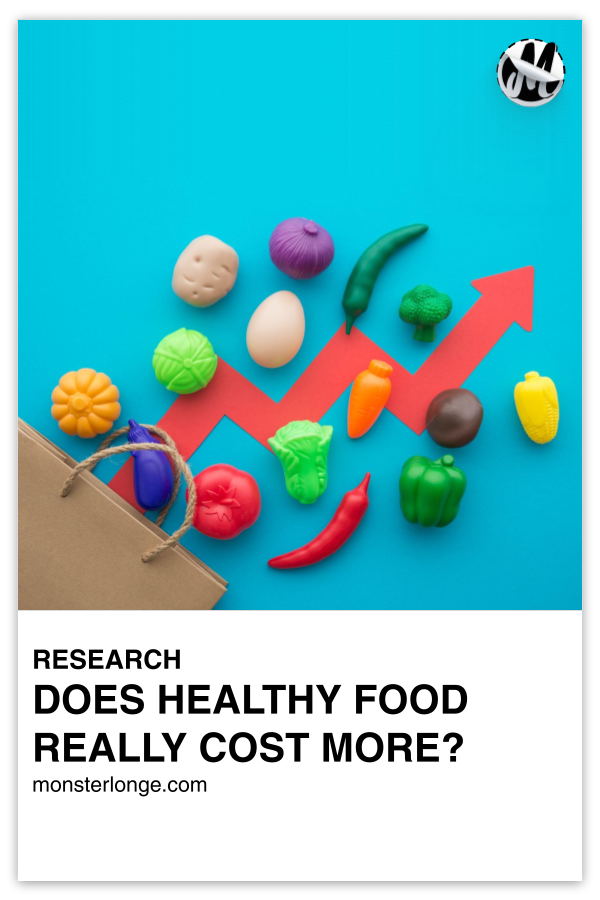
Is Healthy Food More Expensive?
The number one reason people give for why they don’t eat healthy food is because it’s too expensive. So how true is it?
*drum roll*
Healthy food costing more than unhealthy food is very true!
Well, sorta…
Based on a combination of price per serving and per calories, research from Harvard School of Public Health suggests it costs $1.50 more to eat a day’s worth of fruits, veggies, fish, and nuts than it does to eat an unhealthy diet consisting of refined grains and processed meats.
$1.50 more per day comes out to $45 dollars over a 30-day month and close to $550 over the course of a year. While that might seem like a lot of money, it’s really not when you consider other daily expenses, like that cup of gourmet coffee you get every morning, which costs a national average of $4. When looking at it like that, spending an extra $1.50 per day to eat healthier is really small change.
On top of that, coming out of pocket today for an extra $1.50 is far less of a financial burden than the amount of money you’ll have to shell out tomorrow to cover the doctor’s visits, medications, hospital stays, and other medical-care costs related to the serious and chronic diseases and conditions borne by a bad diet, as the risk of heart disease, diabetes, and cancer, among other things, are increased with poor nutrition.1“Tomorrow” is obviously used in the figurative, not literal, sense!
So yeah, healthy food is more expensive than less healthy food.
However, it’s not like you have to take out another mortgage in addition to the ones you already have if you choose to buy apples as a snack in place of potato chips! The truth of the matter is that most people can afford the healthier option. But if you can’t because you’re working with a tight budget, there are reasons to pay the cost irrespective of price because you’re going to pay for how you eat sooner or later.
Healthy food is priced higher than unhealthy fare mainly because of production costs.
For instance, fresh fruits and vegetables require the use of human labor to handpick them. This is not only to weed out produce with physical imperfections but to also prevent bumps and bruises as they’re collected. Compare that expenditure to the use of machines you don’t have to pay to pick fruits and vegetables meant for processed foods where unsightly imperfections don’t matter.
Apart from slavery no longer being legal, another thing that contributes to the cost difference is subsidies. As opposed to wheat, soy, and corn, which receive 40 percent of farm subsidies and are in a majority of processed foods because the cost to grow them is so dirt cheap, only 1 percent of government assistance goes toward incentivizing farmers to overgrow more diverse fruit and vegetable crops. Were more money allocated to that agenda, then it’d drive down the cost of a lot of what’s found in the fresh produce section along the perimeter of the supermarket, which you’re just finding out exists because you only know about the center aisles where the majority of the nutritionally-deficient food items are.
With all of that said though, saying healthy food is too expensive is nothing more than a cop-out to rationalize unhealthy food choices.
But if eating healthy truly is expensive and you can’t, for example, get a higher paying job to earn more or give up a child for adoption to free up money, below are some tips to cut down on your grocery bill.
• Check the weekly circular for promotions and coupons.
• Buy the store brand of grains, rice, beans, and nuts.
• Buy dry goods in bulk.
• Buy fresh fruits and veggies in season.
• Buy fruit, veggies, and fish frozen.
• Buy fresh meat on sale and freeze it.
• Go to your local farmers market around closing time for a deal.
Glossary: calories, diet, nutrition
- How To Eat Healthy During Thanksgiving - November 20, 2024
- Weight Loss Tip: no.2620 - November 20, 2024
- Is Going To The Gym Once A Week Enough? - November 19, 2024
